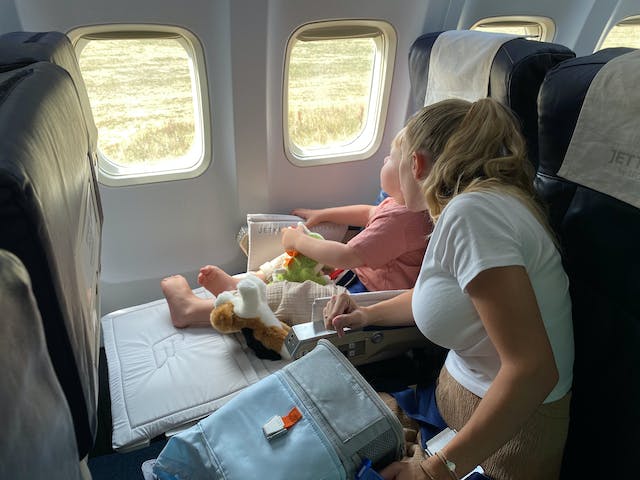|
Get expert tips for minimizing jet lag in children during international travel, ensuring your family's trip is enjoyable and restful. Traveling across time zones with your little ones? You might be bracing for the dreaded jet lag that can turn your dream vacation into a sleep-deprived slog. But fear not, dear parents! Minimizing jet lag in children isn't just a fantasy; it's entirely doable with savvy planning and a sprinkle of patience. Understanding Jet Lag in Children First things first: What is jet lag, and why does it turn our adorable angels into cranky gremlins? Jet lag happens when our internal body clock is out of sync with our time zone, making maintaining sleep routines a real challenge. That can be particularly unsettling for kids whose routines are as sacred as a cherished bedtime story. Unlike adults, children have different sleep needs and may struggle to express discomfort or tiredness, making jet lag a bit trickier to manage. When their internal clocks get muddled, so does their ability to fall asleep and wake up at the usual times. It's not just about a few groggy mornings or early nights; jet lag can unsettle their sleep habits for days, sometimes longer. That’s why understanding how it affects kids is crucial. It’s about more than just being sleepy at the wrong hours; it’s about keeping their sleep rhythms in tune. Let's explore how you can effectively do just that! Preparing Before the Flight Our journey to minimizing jet lag in children begins before we set foot on the plane. So, as you pack up for an international adventure or prepare for an international move, remember that getting ready for jet lag is an essential part of your travel itinerary. That is particularly important if you’re planning a permanent stay. While you can hire professionals to help you relocate abroad with ease, they won’t be able to help with your little ones. So, start by tweaking your child’s bedtime a few days before your flight. If you're moving across time zones permanently, this becomes even more vital. In addition, educate them about jet lag in a fun and engaging way, perhaps turning it into a bedtime story about traveling worldwide. These preparatory steps set the stage for a successful transition to a new home and routine. Minimizing Jet Lag in Children During the Flight Up in the air, it's all about balance. On the one hand, you must keep the kids occupied. On the other hand, you must strategically manage their sleep. If it's nighttime at your destination, encourage them to snooze. Make their travel environment cozy – think soft blankets, comfortable pillows, and perhaps a favorite storybook. Minimizing jet lag means balancing sleep with wakefulness on the plane. Offer quiet activities and avoid too much screen time, as the blue light from devices can mess with their sleep hormones. Every bit of sleep they get on the plane is a step towards a smoother adjustment to the new time zone, making your journey a little more relaxed and enjoyable. Upon Arrival: Embracing the New Time Zone Once you touch down, the real magic begins. Now's the time to embrace your new time zone with open arms. The key to a smooth transition? Dive straight into the local rhythm. If it's day, encourage the kids to bask in the sunlight; it's nature's way of resetting our internal clocks. And when night falls, mimic their usual bedtime routine to signal to their little bodies that it's time to wind down. Also, adjusting sleep schedules upon arrival is essential, and it’s okay if things are a bit topsy-turvy at first. Those first few nights might involve extra cuddles or a story more, but consistency will soon pay off. Try to limit naps to short bursts - think power naps - to avoid a midnight party in pajamas. And when evening comes, dim the lights to encourage their bodies to wind down. Patience, consistency, and a dash of understanding go a long way in helping your family settle into the new time zone. Maintaining Healthy Sleep Habits Consistency is your golden ticket. Maintaining a regular sleep schedule is vital, even when it feels like your internal clocks are playing pinball. Above all, kids thrive on routine, so even if you're in a different time zone, their bodies will appreciate the familiarity of a set bedtime. Balancing rest with activities is also crucial. Too much downtime can make it harder for them to fall asleep at night. Plan some light, engaging activities that aren't overly stimulating to keep them moving and grooving at the right times. Dealing with Challenges Tackling jet lag's quirks can sometimes feel like solving a puzzle, especially with children. Expect a mix of sleepy mornings and wide-awake nights, but don't let that dampen your spirits. Keep the lines of communication open – chat with your kids about how they're feeling and reassure them that it's perfectly normal to feel a bit topsy-turvy after a trip. If you find jet lag stubbornly overstaying its welcome, causing significant sleep disruptions, it might be time to consult an experienced pediatric sleep consultant. They can offer tailored strategies that are just right for your child's unique needs. And remember, every child is different; what works for one may not for another. So, stay adaptable, experiment with different techniques, and soon, you'll find the perfect recipe for easing your family back into a peaceful night's sleep. Conquering jet lag is about teamwork, patience, and some sleep-science magic. Returning Home: Reclaiming Your Routine Once your globe-trotting adventure wraps up, it's time to nudge your family's sleep schedule back to the familiar territory of your home time zone. Begin by gently adjusting bedtimes and wake-up times closer to your usual routine. That might mean a bit of bedtime negotiation and some early birds waking up before the sun, but consistency here is key. Keep in mind that your little ones' internal clocks might be a tad sluggish in readjusting, so patience and a steady routine are crucial. Create a calming bedtime environment to encourage quicker readjustment – think soft lights, soothing music, and perhaps a favorite bedtime story. Don’t forget to keep daytime naps in check; too much daytime snoozing can make nighttime sleep elusive. Above all, keep in mind that it's a gradual process. It might take several days, but with persistence and understanding, your children will eventually resettle into their normal sleep patterns. So, keep the faith; soon enough, your household's rhythms will be humming along just like before your journey.
Sweet Dreams in Any Time Zone And there you have it, dear parents! Jet lag doesn't have to be the monster under the bed. With some preparation, in-flight savvy, and a hearty dose of patience, minimizing jet lag in children is achievable. Every family's journey is unique, so find what works best for you and your little travelers. Here's to sweet dreams, no matter the time zone! Photos via: Pexels Unsplash Pexels Pexels |
To The Moon and Back Sleep ConsultingProviding families the tools & support they need to get their little ones sleeping through the night and napping like champs! Everyone has more fun when they are well rested! Visit Wollino - Discount Code: TOTHEMOONANDBACK10
Browse
All
|
All information provided on this website, including texts, images, and other materials, are for informational purposes only and should not be considered a replacement for assessment or treatment by a healthcare provider.
© COPYRIGHT 2016-2024 TO THE MOON AND BACK SLEEP CONSULTING. ALL RIGHTS RESERVED. WAKING GIRL WEB DESIGN
© COPYRIGHT 2016-2024 TO THE MOON AND BACK SLEEP CONSULTING. ALL RIGHTS RESERVED. WAKING GIRL WEB DESIGN










 RSS Feed
RSS Feed








